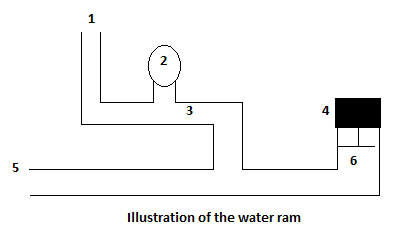
- Solar Energy - Introduction
- Solar Energy - Photovoltaic Effect
- Developing Solar Panel
- Solar Energy - Cell Efficiency
- Types of Photovoltaics
- Geothermal Energy
- Geothermal Energy - Introduction
- Geothermal Energy - Extraction
- Geothermal Energy - Geophysics
- Hydroelectric Power
- Hydroelectric Power - Introduction
- Hydroelectric Power - Turbine Types
- Hydroelectric Power Systems
- Hydraulic Ram Pump
- Renewable Energy Resources
- Renewable Energy - Quick Guide
- Renewable Energy - Resources
- Renewable Energy - Discussion
Hydroelectric Power - Hydraulic Ram Pump
A hydraulic ram pump works under basic laws of physics to lift water against gravitational pull to a height higher than that of the source. This pump works without any external energy supply such as burning of fuel. The only energy is the kinetic energy of the water being pumped. The greater the head the higher the distance pumped.
How it Works?
To understand how the ram pump works, it is important to have knowledge of water hammer principle.
Fluid hammer − The fluid hammer effect occurs when a fluid (in this case water) is forcefully stopped or its direction changes suddenly. A pressure shock is experienced and the wave is conducted back to the source of the fluid. This could be a dangerous phenomenon causing tires and pipes to burst or collapse.

Water flows into the pump through inlet (5) with some kinetic energy from the head and shuts the valve (6).
With 6 closed and 3 initially closed, the water develops a water hummer that builds up pressure in the pipe and opens valve (3) sending some water through the outlet (1).
Since the flow is up hill, water flows slowly and shortly falls back again closing 3.
The water hammer builds up and replicates back through the pipe producing a suction force that opens the waste valve 6.
The process is repeated with pressure building up each time.
Label 2 is a pressure controller containing air. It cushions the shock whenever 6 closer and water is pushed through 3. It helps protect the piping from impact that could lead to bursting as well as aid the pumping effect. The ram is 60 to 80 percent efficient. This does not directly reflect the ratio of water pumped as it relies on the vertical height of water pumped. In other words, this is the efficiency of the pumping effect to energy from the water hummer effect.
Solved Example 1
Calculate the estimated power for a turbine rated with 85 percent efficiency. The flow of the river is 80 cubic meters per second and the streams intake is situated 147 meters from the location of the generator turbines.
Solution −
Power is given by W = Efficiency * head * flow * density * gravity
Converting specific density of water to SI units, we get 1000kgm-3
Substituting the values in the formula −
P = 0.85 * 1000 * 80 * 9.81 * 147
P = 97 Mega Watts
Solved Example 2
Given the actual power received in a particular day was 1,440,000kWh; calculate the efficiency of the generator. Assume gravity to be 9.81 ms-2. Specific density of water 1 gcm-3.
Solution −
Given: 1 days supply = 288000 kWh
Power = 1440000/24
= 60 mW
Efficiency = Power supply/ expected power * 100
= 60/97 * 100
The system is 66.67% efficient.